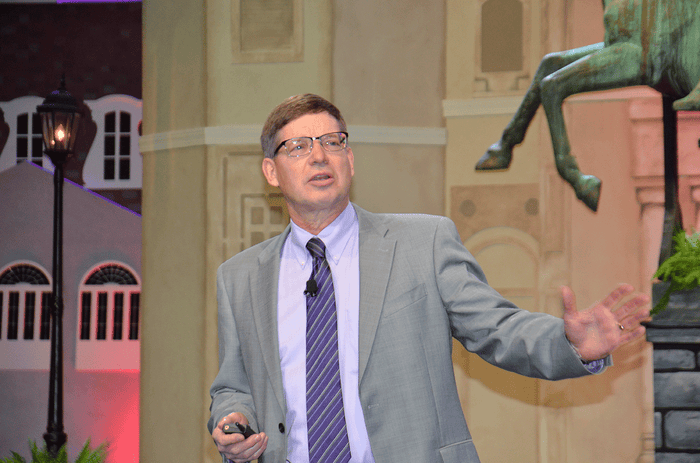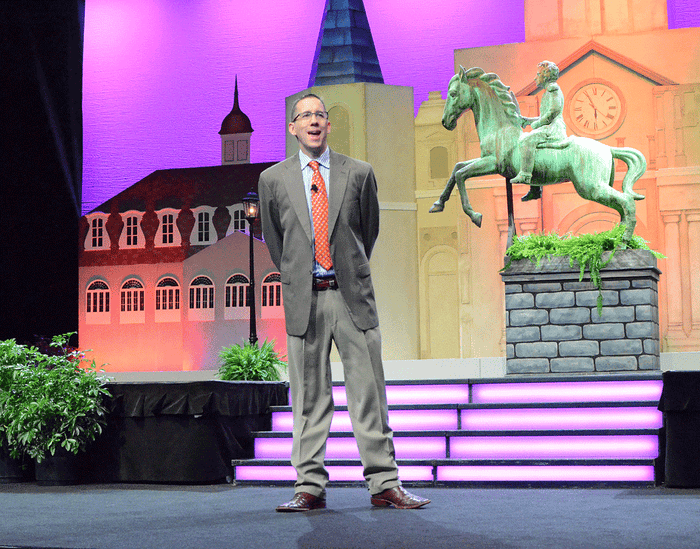Winter weather offers price support early. But then what?
March 4, 2019

Never minding the implied added cost, the wet and harsh winter weather across key cattle-feeding regions will likely provide strong price support — at least for a while.
“We feel like we’re in a weather market,” said Kevin Good, CattleFax analyst, at the CattleFax Outlook Seminar during the annual Cattle Industry Convention in New Orleans in February. “We feel like this is a year where the first half of the year and the second half could look extremely different from a price pattern standpoint.”
According to Good, winter precipitation in the six major cattle- feeding states through January was the most since CattleFax began collecting the data in 1984. “It means weights will drop quicker and further than normal,” Good says.
Steer dressed weights were 883 pounds for the week ending Jan. 12, according to the Actual Slaughter Under Federal In-spection reports from USDA.
That was a staggering 13 pounds less than a year earlier. Dressed heifer weights were 825 pounds, which was 6 pounds less than the same week a year earlier. A week later, steer and heifer dressed carcass weights were 5 pounds less than the same week a year earlier.
If carcass weights are 3% lighter due to weather, compared to a normal year, Good says that’s equivalent to taking 15,000 head of fed cattle per week off the market. If weights are 2% less than normal through the first half of the year, Good explained that’s equivalent to 250,000 head of cattle, which would offset the increased number of cattle on feed at the beginning of the year.
“It helps prices because of the tonnage, but there’s another factor,” Good says. “It tends to keep cattle off the front end. It keeps the front end tighter, greener and more manageable, because it takes more days on feed to get those cattle to come to market. Leverage and reduced tonnage propel the markets to higher levels than you would normally see.”

Kevin Good
Unlike most weather-market years, however, CattleFax expects average carcass weights to increase 2 pounds this year.
If so, that means there will be atypically more price pressure from increased tonnage the second half of the year. In a normal year, Good explains, carcass weights are seasonally heaviest from October to early November; they’re seasonally lightest in May.
“With bigger cattle on feed numbers, with the challenge of shackle space, we think the feeding industry could become very uncurrent as we go through the summer and fall,” Good says.
The challenge with shackle space comes with higher capacity utilization by fewer packing plants and more cattle than a decade ago.
Cattle numbers, production grow
Cattle numbers continue to increase with ongoing herd expansion.
Between mostly positive forage conditions and ongoing profitability last year, CattleFax believes the nation’s cow herd grew by another 200,000 head or so to 31.9 million head as of Jan. 1.
For perspective, CattleFax expects record-large beef production this year of 27.3 billion pounds. Similarly, analysts with USDA’s Economic Research Service (ERS) forecast estimated beef production this year at 27.61 billion pounds in the February World Agricultural Supply and Demand Estimates (WASDE).
ERS also projects record-large total red meat and poultry production at 104.74 billion pounds. It was an estimated 102.38 billion pounds last year.
“Cattle producers, on average, will receive a smaller percentage of the retail beef dollar as larger cattle supplies increase price pressure across all segments of the industry,” according to Good. “Retail beef prices will likely see some inflation in 2019, but larger beef, pork and poultry production will be price-limiting.”
CattleFax projects the all-fresh retail beef price will average $5.73 per pound this year, up 6 cents from year-ago levels. That’s with a projected average composite carcass cutout value of $216 per cwt, a rise of $4 above last year.
Placements press on second half
Added price challenge to the second half of the year likely will come with seasonal placement patterns.
“If you look at September through December of last year, placements were down about 300,000 head,” Good explains. “With good moisture conditions, full feedyards and muddy conditions in those feedyards, we kept a larger percentage of last fall’s calf crop outside of feedyards.”
Those cattle will ultimately head to the feedlot.
“The logical spot they’ll come back is as yearling-weight cattle in March through June. If that’s the case, it will have a tendency to put more fed cattle out there in the late summer and early fall,” Good says.
CattleFax price projections reflect this expectation. Although the annual average price is projected at $117 per cwt, Good sees upside potential this spring of $130 to $132, but downside risk at $100 to $105, particularly for August to October.
By way of comparison, WASDE forecasts first-quarter fed steer prices at $122 to $126. ERS analysts project $119 to $127 in the second quarter, $109 to $119 in the third and $108 to $118 in the fourth.
Steady feed prices are likely
CattleFax projections assume continued domestic economic growth, U.S. beef exports increasing 6% and U.S. beef exports declining 4%, compared to last year.
Prices also assume relatively stable feed prices.
“Corn is expected to trade in a range of $3.60 to $4.10 per bushel during the first half of the year,” CattleFax analyst Mike Murphy says. That’s the practical trading range for spot corn futures.
CattleFax expects corn acreage to increase 2 million acres this year to total 91 million acres, with soybean acreage declining 2.2 million acres to 87 million acres.

Mike Murphy
Although hay acreage is expected to be similar this year, Murphy told Outlook participants improved winter precipitation across much of the U.S. should support production and offer producers some price relief.
CattleFax projects the average price for 550-pound steer calves this year at $164 per cwt, which would be $9 less than last year.
“Values in the spring should have the potential to reach the mid-$180s,” Good says. “On the other hand, a larger calf crop and softer demand have the potential to erode prices to the $140 level next fall, so there is certainly more price risk in feeder cattle and calves than in the fed cattle markets in 2019.”
Feeder steer prices (750 pounds) are pegged at $147 per cwt, down $3 from a year earlier, with a range of $130 to $160.
“Larger supply of cattle outside of feedyards, coupled with limited profitability in the feeding sector, will hinder demand and pressure feeder cattle prices,” Good says.
As for cull cows, Good explains, “Years of expansion and poor operating margins in the dairy sector are generating more cull cows, which weighs on the markets. The additional supply and the limited packing capacity for non-fed cattle will result in a market which averages approximately $55 per cwt during 2019, with a spring high near $60 and a fall low in the lower $40s.”
Bred cow prices are expected to be $100 less, at an average price of $1,550 per head. CattleFax expects a full range of $1,200 to $1,800 for load lots of running-age cows.
Although CattleFax expects cow-calf producers to remain profitable this year, on average, Good notes, “We expect to see margins begin to compress and leverage to shift from the cow-calf and stocker sectors to the feeder as we expand the supply of cattle.”
About the Author(s)
You May Also Like





